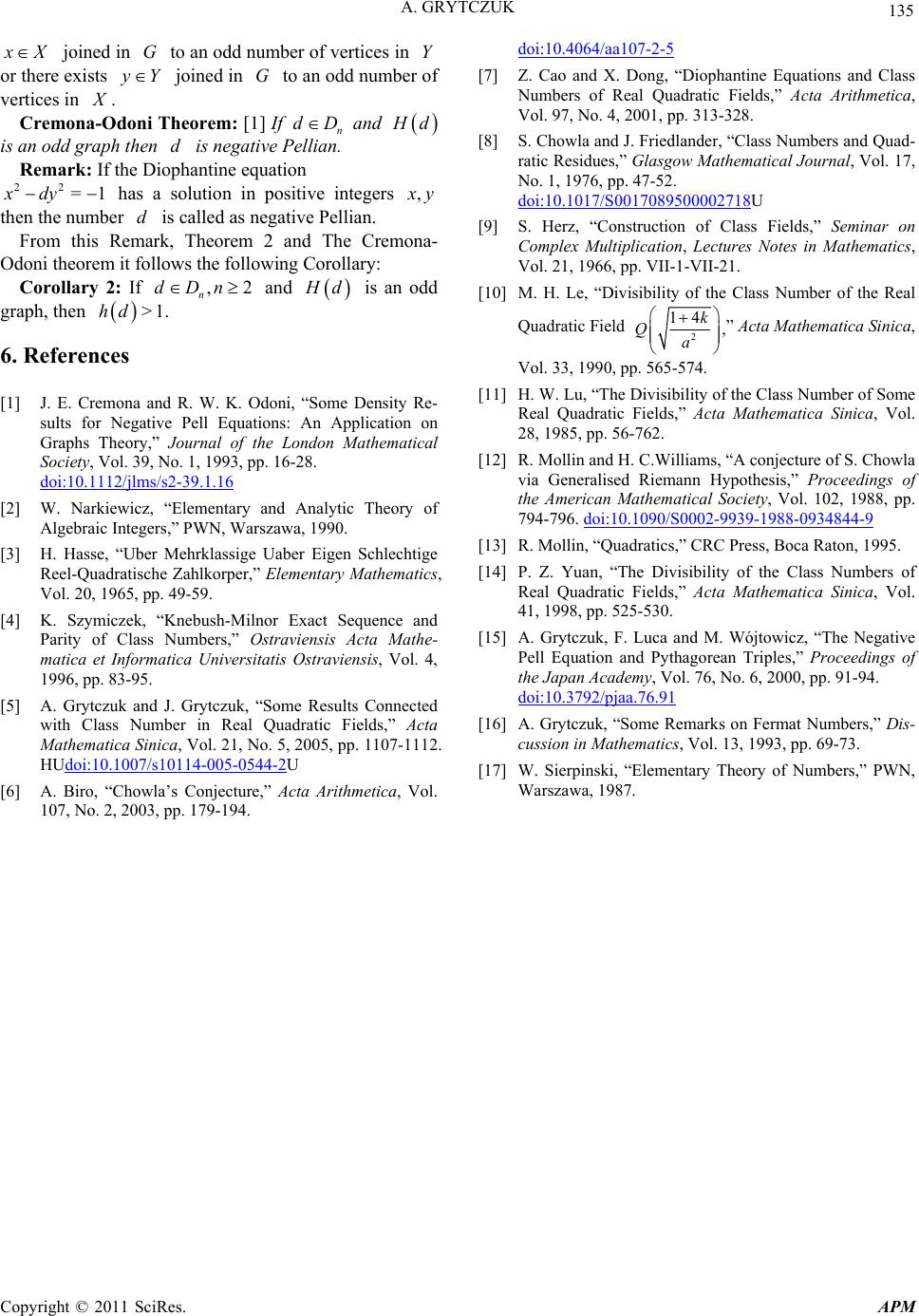
A. GRYTCZUK
Copyright © 2011 SciRes. APM
135
X joined in G to an odd number of vertices in
or there exists
Y
Y joined in G to an odd number of
vertices in
.
Cremona-Odoni Theorem: [1] If n and
dD
d
,
is an odd graph then is negative Pellian.
d
Remark: If the Diophantine equation
has a solution in positive integers
22
xd=1y
y
then the number is called as negative Pellian.
d
From this Remark, Theorem 2 and The Cremona-
Odoni theorem it follows the following Corollary:
Corollary 2: If and ,
n
dDn2
d is an odd
graph, then
>1.hd
6. References
[1] J. E. Cremona and R. W. K. Odoni, “Some Density Re-
sults for Negative Pell Equations: An Application on
Graphs Theory,” Journal of the London Mathematical
Society, Vol. 39, No. 1, 1993, pp. 16-28.
doi:10.1112/jlms/s2-39.1.16
[2] W. Narkiewicz, “Elementary and Analytic Theory of
Algebraic Integers,” PWN, Warszawa, 1990.
[3] H. Hasse, “Uber Mehrklassige Uaber Eigen Schlechtige
Reel-Quadratische Zahlkorper,” Elementary Mathematics,
Vol. 20, 1965, pp. 49-59.
[4] K. Szymiczek, “Knebush-Milnor Exact Sequence and
Parity of Class Numbers,” Ostraviensis Acta Mathe-
matica et Informatica Universitatis Ostraviensis, Vol. 4,
1996, pp. 83-95.
[5] A. Grytczuk and J. Grytczuk, “Some Results Connected
with Class Number in Real Quadratic Fields,” Acta
Mathematica Sinica, Vol. 21, No. 5, 2005, pp. 1107-1112.
HUdoi:10.1007/s10114-005-0544-2U
[6] A. Biro, “Chowla’s Conjecture,” Acta Arithmetica, Vol.
107, No. 2, 2003, pp. 179-194.
doi:10.4064/aa107-2-5
[7] Z. Cao and X. Dong, “Diophantine Equations and Class
Numbers of Real Quadratic Fields,” Acta Arithmetica,
Vol. 97, No. 4, 2001, pp. 313-328.
[8] S. Chowla and J. Friedlander, “Class Numbers and Quad-
ratic Residues,” Glasgow Mathematical Journal, Vol. 17,
No. 1, 1976, pp. 47-52.
doi:10.1017/S0017089500002718U
[9] S. Herz, “Construction of Class Fields,” Seminar on
Complex Multiplication, Lectures Notes in Mathematics,
Vol. 21, 1966, pp. VII-1-VII-21.
[10] M. H. Le, “Divisibility of the Class Number of the Real
Quadratic Field 2
14 ,
k
Qa
” Acta Mathematica Sinica,
Vol. 33, 1990, pp. 565-574.
[11] H. W. Lu, “The Divisibility of the Class Number of Some
Real Quadratic Fields,” Acta Mathematica Sinica, Vol.
28, 1985, pp. 56-762.
[12] R. Mollin and H. C.Williams, “A conjecture of S. Chowla
via Generalised Riemann Hypothesis,” Proceedings of
the American Mathematical Society, Vol. 102, 1988, pp.
794-796. doi:10.1090/S0002-9939-1988-0934844-9
[13] R. Mollin, “Quadratics,” CRC Press, Boca Raton, 1995.
[14] P. Z. Yuan, “The Divisibility of the Class Numbers of
Real Quadratic Fields,” Acta Mathematica Sinica, Vol.
41, 1998, pp. 525-530.
[15] A. Grytczuk, F. Luca and M. Wójtowicz, “The Negative
Pell Equation and Pythagorean Triples,” Proceedings of
the Japan Academy, Vol. 76, No. 6, 2000, pp. 91-94.
doi:10.3792/pjaa.76.91
[16] A. Grytczuk, “Some Remarks on Fermat Numbers,” Dis-
cussion in Mathematics, Vol. 13, 1993, pp. 69-73.
[17] W. Sierpinski, “Elementary Theory of Numbers,” PWN,
Warszawa, 1987.